Cycling is one of the best ways to stay active, build strength, and enjoy the outdoors. For amputees, riding a bike offers freedom, fitness, and an incredible sense of achievement. Whether cycling for leisure, commuting, or competitive sports, the right prosthetic leg can make all the difference in comfort, performance, and control.
Pedaling with a prosthetic limb requires balance, proper alignment, and the right level of flexibility. Standard walking prosthetics may not provide the movement needed for smooth cycling, but specially designed biking prosthetics offer better range, power, and efficiency. With advancements in prosthetic technology, amputees can now enjoy cycling with the same ease and confidence as anyone else.
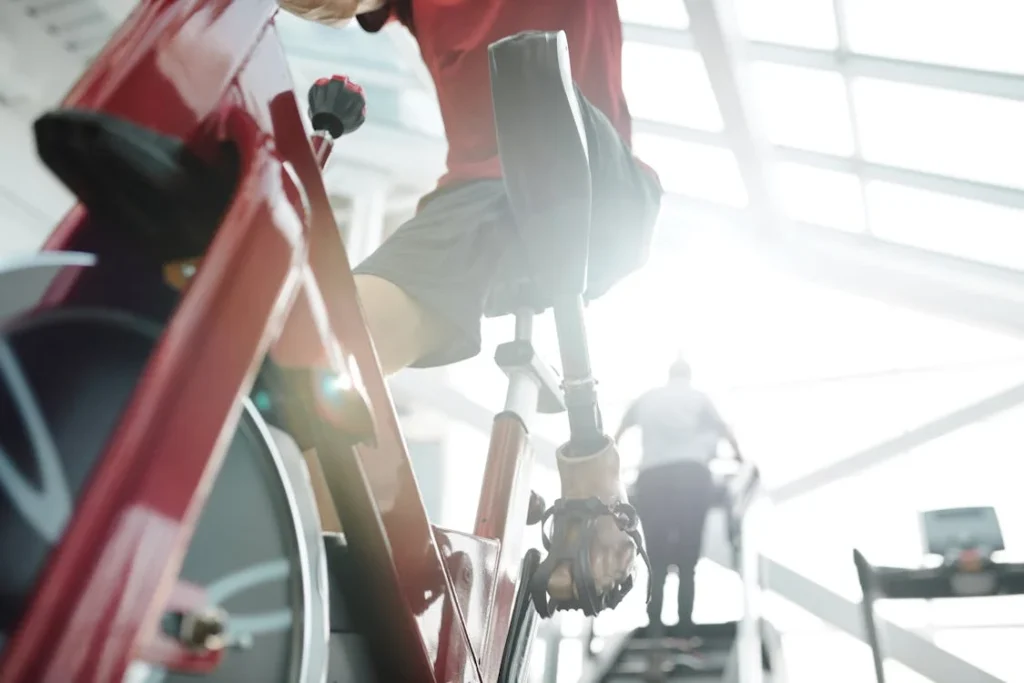
How Cycling with a Prosthetic Leg Works
Riding a bike with a prosthetic leg is entirely possible with the right approach. The key to success is understanding how the prosthetic interacts with the pedals, ensuring stability, and making necessary adjustments to improve comfort and performance.
Unlike walking, cycling requires continuous circular motion, making flexibility and alignment crucial.
Understanding Pedaling Mechanics
Pedaling involves two key motions: the downstroke and the upstroke. The downstroke is when the foot pushes the pedal downward, generating power.
The upstroke, while less forceful, helps maintain smooth movement and prepares the leg for the next downstroke. For amputees, the challenge is ensuring that the prosthetic provides enough flexibility and grip for consistent pedaling without unnecessary strain.
For below-the-knee amputees, the focus is on securing the foot in place and optimizing knee movement. A prosthetic foot with good ankle flexibility can help with a natural cycling motion.
For above-the-knee amputees, the knee joint of the prosthetic plays a major role in how efficiently the leg moves through the pedaling cycle. A knee with adjustable resistance can provide smoother control, preventing stiffness or excessive movement.
Adapting to Balance and Stability
Cycling requires balance, especially when starting, stopping, or riding on uneven terrain. A prosthetic that is too rigid can make mounting the bike difficult, while one with too much movement may cause instability. Finding the right balance between flexibility and control is essential.
Many cyclists with prosthetic legs use adapted cleat systems or toe clips to keep the prosthetic foot securely on the pedal. This helps prevent slipping and allows for a smoother ride.
Some riders also choose a shorter crank arm on the side of their prosthetic to reduce strain on the knee and make pedaling more natural.
Customizing the Bike for Comfort
While choosing the right prosthetic is important, making adjustments to the bike itself can also improve the cycling experience.
A slightly lower saddle height can make mounting and dismounting easier, while adjusting the handlebars can improve posture and reduce strain on the back and shoulders.
Gearing also plays a role in adapting to a prosthetic limb. Starting in a lower gear reduces resistance, making it easier to build momentum and find a comfortable rhythm. Over time, as strength and confidence grow, riders can adjust their gearing to match their preferred pace.
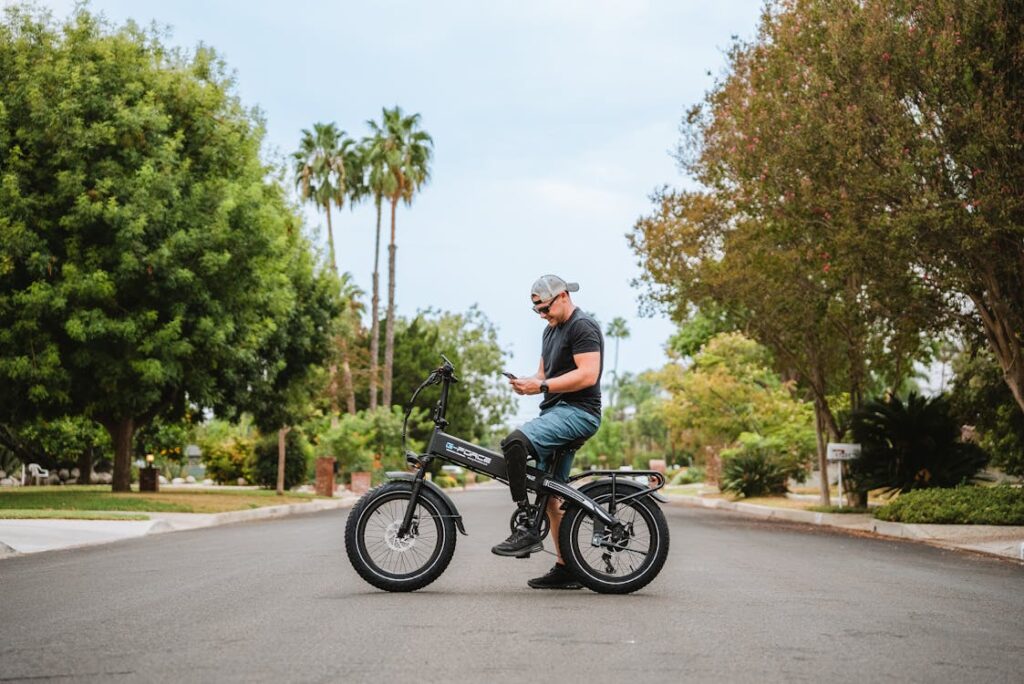
Best Prosthetic Legs for Cycling
Choosing the right prosthetic leg for cycling is crucial for comfort, performance, and efficiency. Not all prosthetics are designed for the demands of pedaling, so finding one with the right features can make a huge difference.
From specialized cycling prosthetics to adjustable everyday models, there are several options to consider based on your riding style and level of activity.
Prosthetic Legs for Below-the-Knee Amputees
For cyclists with a below-the-knee (BK) amputation, the main challenge is ensuring that the prosthetic foot remains secure on the pedal while allowing enough flexibility for smooth motion.
Some prosthetic feet come with adjustable ankle joints, which help mimic the natural movement of a foot during cycling. A rigid foot may work for high-speed riding but can make pedaling feel unnatural for casual cyclists.
One common adaptation for BK cyclists is the use of cycling-specific feet with a curved or energy-return design. These models help transfer energy efficiently from the leg to the pedal, improving both speed and endurance.
Some cyclists also choose prosthetic feet with built-in cleats or use adaptive pedals that provide a strong connection between the prosthetic and the bike.
Prosthetic Legs for Above-the-Knee Amputees
Cyclists with an above-the-knee (AK) amputation need a prosthetic knee that supports the constant movement of pedaling. A traditional walking prosthetic knee may feel stiff or awkward, but advanced cycling knees allow for fluid motion and controlled resistance.
One of the most effective options is a free-swinging knee joint, which reduces resistance during the pedaling motion. This allows the prosthetic leg to follow through with each stroke without requiring excessive effort.
Some models come with adjustable resistance settings, enabling riders to fine-tune the knee’s responsiveness based on their riding speed and terrain.
For those who want extra control, a shortened crank arm on the prosthetic side can reduce the range of motion needed for pedaling, making it easier to maintain a steady cadence.
Many AK cyclists also use a strap or clip system to ensure the prosthetic foot stays firmly on the pedal without slipping.
Bionic and Microprocessor-Controlled Prosthetics
With advancements in prosthetic technology, bionic and microprocessor-controlled knees have become an excellent option for cyclists.
These high-tech prosthetics use sensors and computer algorithms to adjust knee resistance in real time, making pedaling smoother and more efficient.
Some even allow users to switch between different activity modes, ensuring that the prosthetic functions optimally for both walking and cycling.
While bionic prosthetics come at a higher cost, they offer greater control and adaptability, especially for riders who enjoy long-distance cycling or competitive events.
These smart prosthetics can be customized to individual cycling styles, helping riders maintain a natural motion with less fatigue.
Custom Solutions for Recreational and Competitive Cyclists
For casual riders who simply want to enjoy a comfortable bike ride, a well-fitted everyday prosthetic with slight modifications may be enough.
However, for those looking to take on more intense cycling—such as road racing, mountain biking, or triathlons—investing in a high-performance sports prosthetic can significantly improve power, efficiency, and endurance.
At Robobionics, we specialize in prosthetic solutions tailored for active lifestyles. Whether you need a lightweight, energy-return prosthetic for road cycling or a durable, high-performance limb for extreme biking conditions, our team can help you find the best fit for your needs.
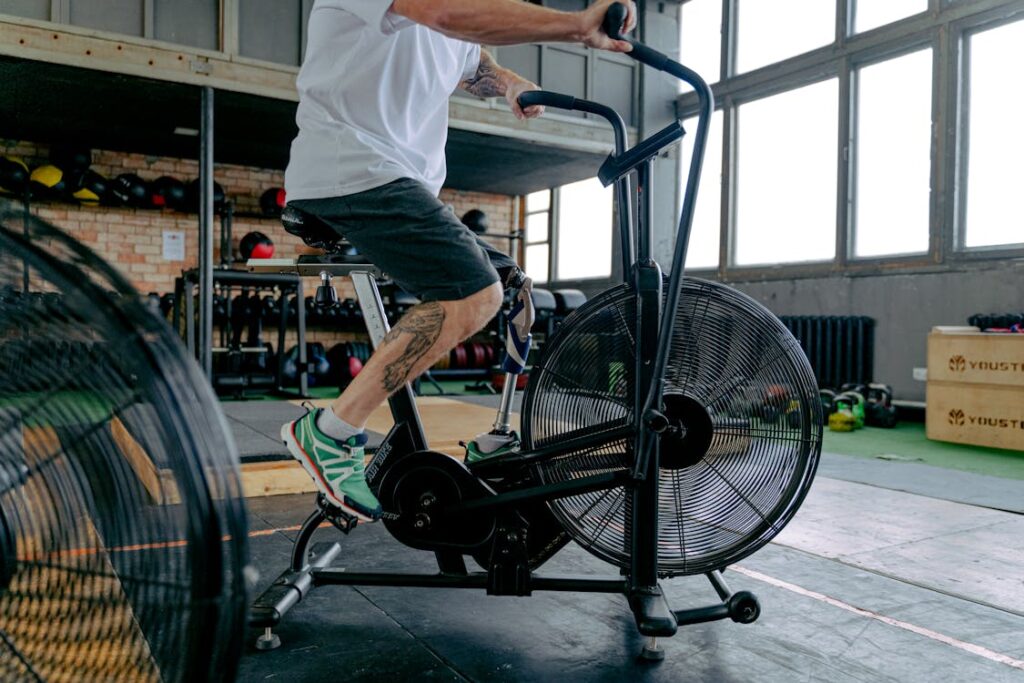
Training and Adapting to Cycling with a Prosthetic Leg
Learning to cycle with a prosthetic leg requires patience, practice, and gradual adaptation. While it may feel challenging at first, building strength, balance, and confidence over time makes riding more comfortable and enjoyable.
The key is to start slow, listen to your body, and make small adjustments as needed.
Building Strength and Endurance
Cycling relies heavily on leg power and core stability. For amputees, strengthening the muscles that support the prosthetic limb is essential for maintaining balance and improving efficiency.
Exercises that focus on hip flexors, glutes, and core stability can make pedaling smoother and prevent strain. Strength training with resistance bands, squats, and controlled leg presses helps build the endurance needed for longer rides.
Cardiovascular training is also important, as cycling is an endurance sport. Starting with short rides on flat surfaces and gradually increasing distance and intensity allows the body to adapt.
Stationary cycling is a great way to practice without the added challenge of outdoor terrain or traffic.
Perfecting Pedal Technique
Proper pedaling technique makes cycling easier and reduces fatigue. Amputees often find that adjusting the pedal stroke angle and foot positioning improves efficiency.
If the prosthetic foot tends to slip off the pedal, using a clip-in system, straps, or toe cages helps keep it securely in place.
Above-the-knee amputees may need to adjust the resistance of their prosthetic knee joint to prevent it from locking up or swinging too freely. Experimenting with crank arm length and seat positioning also helps find the most comfortable and effective pedaling motion.
Balancing and Stopping Safely
Balance is one of the biggest concerns when cycling with a prosthetic limb. Since most of the control comes from the intact leg, practicing weight distribution is essential.
Starting with a wider stance and keeping a low center of gravity makes it easier to maintain balance, especially when stopping or making turns.
Stopping safely requires planning. Many amputee cyclists prefer to lean slightly toward their intact leg when coming to a stop to prevent tipping over.
Lowering the bike seat slightly can also help with stability. Practicing slow stops in a safe environment before riding in traffic or rough terrain is a good way to build confidence.
Overcoming Common Challenges
Cycling with a prosthetic leg comes with unique challenges, but most can be solved with small adjustments. One common issue is residual limb discomfort from prolonged pressure on the prosthetic socket.
Using a well-fitted liner and making periodic adjustments to the socket can help prevent irritation.
Another challenge is maintaining an even cadence, as some prosthetics may not provide equal power on both sides. Training the intact leg to match the rhythm of the prosthetic and using a higher cadence with lower resistance can create a smoother ride.
Weather conditions can also affect riding. In colder temperatures, prosthetic joints may become stiffer, while heat can cause socket discomfort. Wearing weather-appropriate gear and maintaining the prosthetic properly ensures a more comfortable experience.
At Robobionics, we work closely with cyclists to fine-tune their prosthetic limbs for biking. Whether you’re starting out or looking to improve your performance, our expert team can help you make the necessary adjustments for a smoother, safer ride.
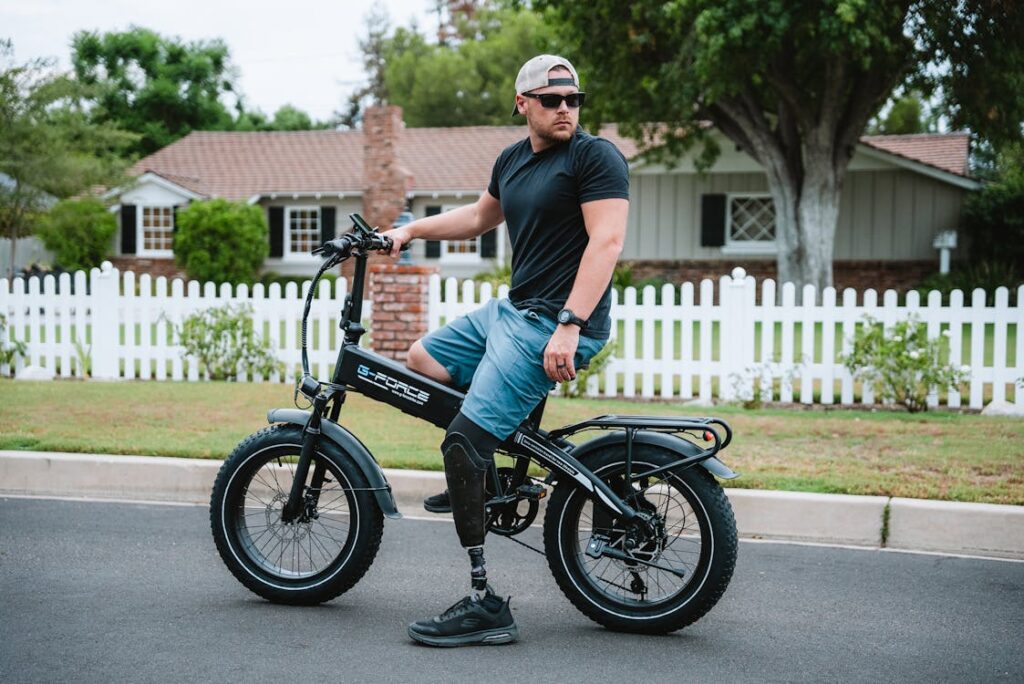
Cycling for Different Riding Styles: Road, Mountain, and Commuting
Cycling with a prosthetic limb isn’t limited to one type of riding. Whether you’re interested in smooth road cycling, tackling rough mountain trails, or using your bike for daily commuting, there are prosthetic options and techniques suited for each style.
Understanding the unique demands of different cycling disciplines can help you choose the best prosthetic setup for your needs.
Road Cycling: Speed and Endurance
Road cycling focuses on long distances, speed, and efficiency. The smoother terrain allows for steady pedaling, making it easier to maintain rhythm and cadence.
For road cyclists, lightweight prosthetics with energy-return feet or adjustable knee joints are ideal, as they allow for smoother propulsion with less effort.
Aerodynamics play a role in competitive road cycling, so having a well-fitted socket ensures that the prosthetic limb doesn’t create unnecessary drag.
A clipless pedal system can improve power transfer, keeping the prosthetic foot firmly in place while reducing wasted movement. Many road cyclists with above-the-knee amputations prefer microprocessor-controlled knees for precise control and smoother pedaling.
Mountain Biking: Control and Stability on Rough Terrain
Mountain biking is all about control, balance, and handling unpredictable terrain. Riders need to adapt quickly to bumps, rocks, and sudden turns, which makes having a secure, shock-absorbing prosthetic essential.
Unlike road cycling, where smooth pedaling is key, mountain biking requires rapid adjustments in body position to navigate obstacles.
For below-the-knee amputees, prosthetics with flexible ankle movement allow for better shock absorption when going over rough terrain.
Above-the-knee riders often benefit from a proprioceptive knee, which provides better stability when shifting weight while riding downhill or standing up on the pedals.
A grippy foot shell or adaptive pedal system prevents the prosthetic foot from slipping, especially on steep inclines. Some riders even use knee suspension systems to reduce impact and strain on their residual limb when landing jumps or going over obstacles.
Commuting and Urban Cycling: Comfort and Efficiency
For daily commuting, comfort and practicality matter most. Riders need a prosthetic that allows for both cycling and walking, making modular or multi-purpose prosthetics a great choice.
A prosthetic with a quick-release foot attachment allows easy switching between cycling and walking modes, making it convenient for getting on and off the bike in busy city environments.
Stopping and starting at traffic lights, navigating crowded streets, and maneuvering through tight spaces all require excellent balance and control.
Riders with a prosthetic leg may benefit from adjustable seat heights or a dropper post, which makes mounting and dismounting easier. Some commuters also use flat pedals with straps instead of clipless systems to allow for quick foot removal when stopping.
Weather conditions are another factor for urban cyclists. In rainy or cold weather, choosing a water-resistant prosthetic with a non-slip foot grip helps maintain safety and comfort.
Regular maintenance is also important, as exposure to dust, water, and road debris can wear down prosthetic components faster.
At Robobionics, we design prosthetics that match your riding style, whether you’re a long-distance road cyclist, an adventurous mountain biker, or someone who simply enjoys riding to work.
We offer customized solutions that balance durability, performance, and comfort to ensure you get the most out of every ride.
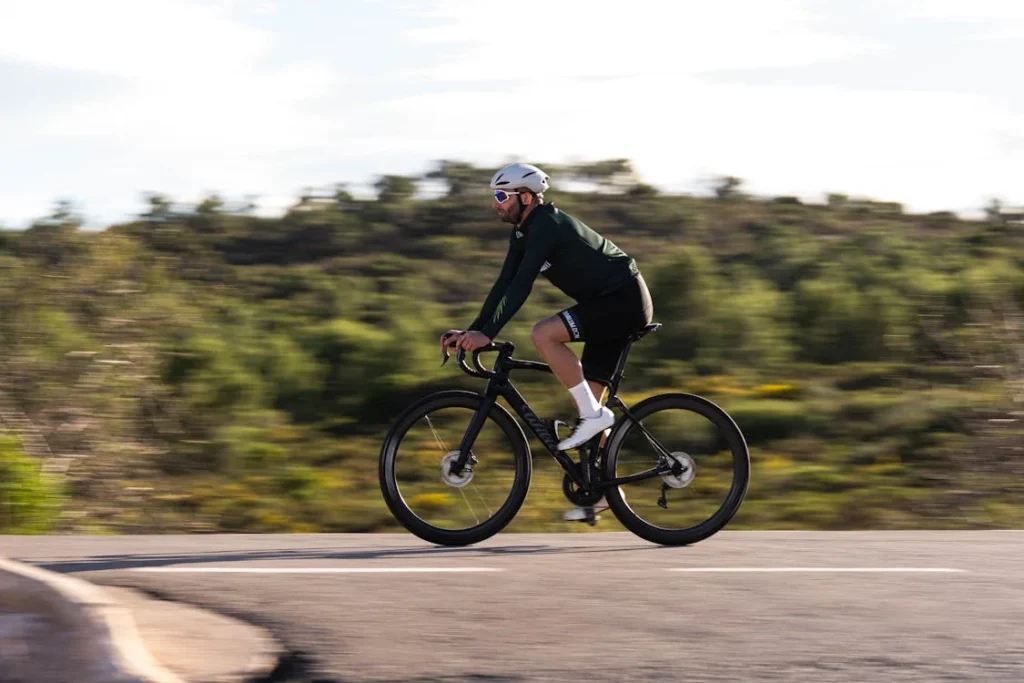
Overcoming Psychological Barriers to Cycling with a Prosthetic Limb
Cycling with a prosthetic leg is not just a physical challenge—it’s also a mental one. Many amputees experience hesitation, self-doubt, or fear when getting back on a bike for the first time.
Concerns about balance, falling, or whether the prosthetic will perform as expected can create uncertainty. However, overcoming these mental barriers is just as important as building physical strength.
Building Confidence Through Small Wins
Confidence doesn’t come overnight, but small achievements build momentum. The key is to start with realistic, achievable goals. This might mean practicing mounting and dismounting the bike before focusing on pedaling.
Riding short distances in a controlled environment, such as an empty parking lot or a bike path, helps build comfort without external pressures like traffic or rough terrain.
Gradually increasing difficulty—such as moving from flat surfaces to gentle slopes—allows riders to develop trust in their prosthetic and their ability. Every small success reinforces the idea that cycling is possible and enjoyable.
Managing Fear of Falling
The fear of falling is one of the biggest concerns for amputee cyclists. Unlike walking, where balance is distributed evenly, cycling requires shifting weight and reacting to motion. A few strategies can help reduce anxiety around this:
- Using a stationary bike first: Practicing pedaling in a fixed position allows riders to get used to the motion of cycling without worrying about balance.
- Starting with a three-wheeled recumbent bike: These bikes provide more stability, allowing riders to focus on technique before transitioning to a standard bicycle.
- Practicing controlled stops: Learning how to slow down and put the intact leg down at the right time makes stopping smoother and safer.
- Riding with a support partner: Having a friend, coach, or cycling mentor nearby for early rides provides reassurance and immediate assistance if needed.
Shifting Mindset from Limitation to Possibility
Many amputees struggle with comparing their current ability to their pre-amputation self or to non-amputee cyclists. The reality is that cycling with a prosthetic is different—but not impossible. Shifting focus from what has changed to what is possible creates a healthier mindset.
Instead of seeing the prosthetic as a limitation, it helps to see it as a tool that allows movement. Watching videos of adaptive cyclists, joining amputee sports groups, and hearing success stories from other riders can be highly motivating.
Surrounding oneself with a supportive community—whether online or in-person—reinforces the belief that cycling is not just possible but also rewarding.
Turning Cycling into an Enjoyable Routine
The more cycling becomes part of a regular routine, the less intimidating it feels.
Committing to riding a certain number of times per week, setting personal challenges, or simply using the bike for errands makes cycling feel natural. Over time, it shifts from a conscious effort to an enjoyable habit.
At Robobionics, we believe that the journey to cycling confidence starts with the right mindset and the right prosthetic. Our specialized cycling prosthetics provide comfort, efficiency, and adaptability, helping you enjoy the sport without limitations.
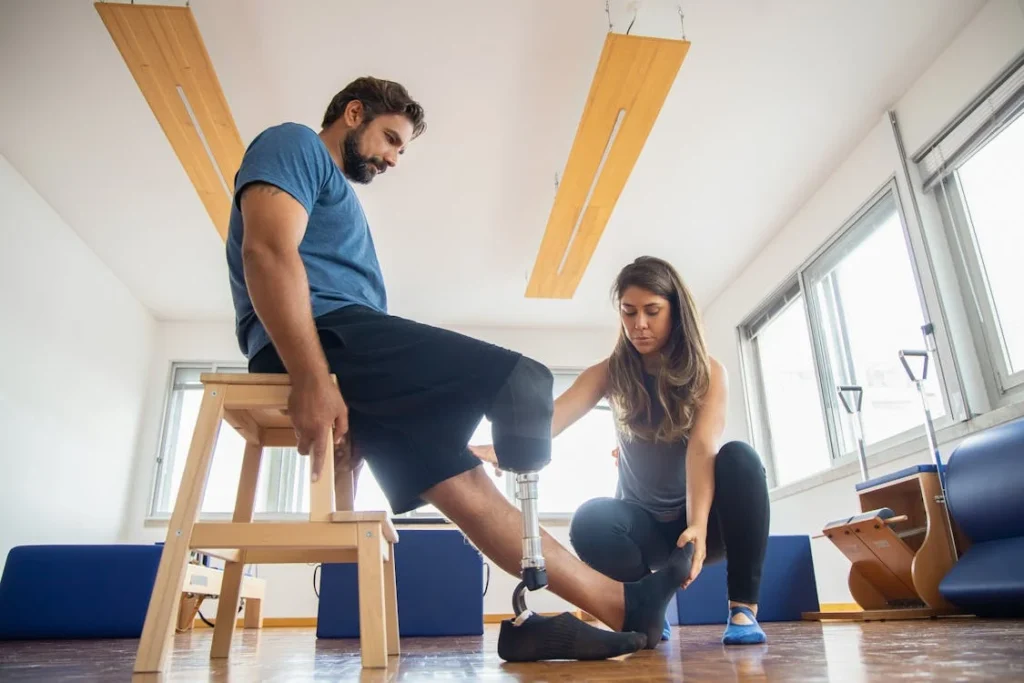
Maintaining and Caring for Your Prosthetic Leg for Cycling
Cycling places unique demands on a prosthetic limb, requiring regular maintenance to ensure smooth performance and long-term durability.
Whether you ride occasionally or cycle daily, taking care of your prosthetic prevents unnecessary wear, improves comfort, and enhances safety. A well-maintained prosthetic helps maintain efficiency, preventing mechanical issues that could affect your ride.
Inspecting Your Prosthetic Before and After Rides
Just like checking your bike before a ride, inspecting your prosthetic is essential. Ensuring that all components—joints, sockets, and foot attachments—are secure prevents potential malfunctions.
Look for loose screws, cracks, or excessive wear in high-stress areas, such as the knee joint (for above-the-knee riders) or the foot attachment (for below-the-knee riders).
After every ride, cleaning off dirt, dust, and sweat helps maintain the prosthetic’s condition. Moisture buildup from sweat can cause discomfort and even lead to skin irritation, so wiping the socket with a dry cloth and using a breathable liner is recommended.
Adjusting and Aligning for Better Performance
Over time, minor adjustments may be needed to optimize your cycling experience. If the prosthetic feels uncomfortable during longer rides or if pedaling becomes uneven, a prosthetist can fine-tune the alignment.
Adjusting the resistance of the prosthetic knee (for AK riders) or modifying the angle of the prosthetic foot can improve energy efficiency and reduce strain.
If using a clip-in pedal system, periodically checking the cleat attachment ensures that it remains secure. An improperly positioned cleat can affect knee alignment and overall balance, leading to discomfort or inefficient pedaling.
Preventing Wear and Tear
Cycling exerts repetitive pressure on a prosthetic, so certain components may wear out faster than in everyday use. Shock-absorbing features like knee suspension or flexible foot plates should be checked regularly, as their effectiveness can decrease over time.
High-impact riding, such as mountain biking, may require reinforced prosthetic components to withstand rough terrain and frequent jumps.
For riders who cycle in different weather conditions, protecting the prosthetic from extreme temperatures, water, and debris is essential. Waterproof covers help in rainy conditions, while proper ventilation reduces heat buildup in warm weather.
When to Replace or Upgrade Your Prosthetic
As cycling skills improve, many amputees transition from general-use prosthetics to more specialized cycling prosthetics.
If a prosthetic starts feeling restrictive, heavy, or inefficient, it may be time to explore lighter materials, better suspension systems, or microprocessor-controlled knees for smoother pedaling.
A well-maintained prosthetic not only enhances cycling performance but also reduces long-term strain on the body. At Robobionics, we provide customized solutions for cycling prosthetics, ensuring that every rider gets the best combination of durability, comfort, and efficiency.
Conclusion
Cycling with a prosthetic leg is not just possible—it’s empowering. Whether you ride for fitness, adventure, or daily commuting, the right prosthetic can make cycling smooth, comfortable, and enjoyable. With advancements in prosthetic technology, riders can now experience better balance, efficiency, and control, making the sport more accessible than ever.
Adapting to cycling takes time, patience, and the right setup. From choosing the best prosthetic leg for biking to making small adjustments for comfort, every step helps create a more seamless riding experience. Regular maintenance ensures longevity, while strength training and practice improve endurance and confidence.
At Robobionics, we believe that no one should have to give up their passion for cycling due to limb loss. Our customized cycling prosthetics are designed for durability, performance, and ease of use, helping you ride without limitations.
Ready to experience the freedom of cycling? Book a free consultation with us today and find the perfect prosthetic leg for your biking journey!



